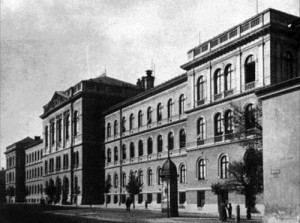A Short History of the Faculty
 The history of the Cluj University can be traced back to May 12, 1581, when a Jesuit Academic College was founded in the city. In 1603 the University buildings were destroyed, but in 1698 the University of Cluj was re-established by the Austrian Emperor Leopold I, with Latin as the working language which, in 1776 was replaced with German. In 1784 the University was turned into a Latin Lyceum. On October 12, 1872, a new University of Cluj was once again set up, strictly in Hungarian this time, with four faculties: Law; Medicine; Philosophy, Letters and History; Mathematics and Natural Sciences. In 1901 the central building of the University of Cluj was opened. Famous mathematicians as F. Riesz, L. Fejėr, A. Haar, Gy. Farkas worked at the Cluj University during this period.
The history of the Cluj University can be traced back to May 12, 1581, when a Jesuit Academic College was founded in the city. In 1603 the University buildings were destroyed, but in 1698 the University of Cluj was re-established by the Austrian Emperor Leopold I, with Latin as the working language which, in 1776 was replaced with German. In 1784 the University was turned into a Latin Lyceum. On October 12, 1872, a new University of Cluj was once again set up, strictly in Hungarian this time, with four faculties: Law; Medicine; Philosophy, Letters and History; Mathematics and Natural Sciences. In 1901 the central building of the University of Cluj was opened. Famous mathematicians as F. Riesz, L. Fejėr, A. Haar, Gy. Farkas worked at the Cluj University during this period.
After World War I, Transylvania was united with the rest of Romania (1918), and in 1919 the Dacia Superioară University was founded, after which, a Mathematical Department was created at the Science Faculty. From the very beginning, this Department was supported by great personalities from other Romanian Universities, like Gheorghe Tiţeica, Dimitrie Pompeiu, Petre Sergescu, Gheorghe Bratu, Aurel Angelescu, Gheorghe Nichifor, Nicolae Abramescu.
After the end of the World War II the University received the name Victor Babeş University. In 1945 another University was set up in Cluj, in the Hungarian language with the name Bolyai University. In 1959 the two universities of Cluj were reunited in the Babeş-Bolyai University, which offered education both in Romanian and Hungarian.
Throughout its existence the Romanian school of Mathematics endeavoured to create in Romania the mathematical research means used in the world’s major Universities. In order to accomplish this objective, at the new University set up in 1919 in Cluj, a Mathematical Seminar was founded at the Mathematical Department, which had Dimitrie Pompeiu as its first head, later joined by the French mathematician Paul Montel. This Seminar published monographs in Cluj and Paris. Noteworthy is the fact that the first mathematical research paper, published by the well-known Gauthier-Villars Publishing House, was written by Paul Montel in Cluj, and was called “Publications du Séminaire Mathematique de l’Université de Cluj”.
It was in 1929 when the publishing of “Mathematica”, the review of the Mathematical Seminar started, having Gh. Tiţeica and D. Pompeiu as directors, and P. Sergescu as secretary. In the same year, as a result of the research achievements, the First International Congress of the Romanian Mathematicians was held in Cluj with a prestigious international participation (Vito Voltera, V.Sierpinski, Paul Montel, Jean Perrin). The setting up of a mathematical library began in the same period. On these solid bases, new research groups were formed in the main fields of Mathematics, such as: Mathematical Analysis, Algebra, Function Theory, Geometry, Differential Equations, Mechanics, and Astronomy.
After the Second World War the research techniques became more and more up-to-date, and new research fields were added. As a consequence, within the University of Cluj a powerful Mathematical school was developed, a school that carries on the prestigious activity of some most distinguished Mathematicians, such as: Dimitrie Pompeiu (1873-1954), Gheorghe Bratu (1881-1941), Theodor Angheluţă (1882-1964), Petre Sergescu (1893-1954), Nicolae Abramescu (1884-1948), Gheorghe Demetrescu (1885-1969), Aurel Angelescu (1886-1938), George Iuga (1871-1958), Eugen Gergely (1896-1974), Ioin Armeanca (1900-1954), George Călugăreanu (1902-1976), Tiberiu Popoviciu (1906-1975), Dumitru V. Ionescu (1901-1985), Tiberiu Mihăilescu (1902-1979), Gheorghe Pic (1907-1984), Caius Iacob (1912-1993), Gheorghe Chiş (1913-1981), Francisc Radó (1921-1990), Ioan Maruşciac (1925-1987), Pál Árpád (1929-2006), Marian Tarină (1932-1992), Ioan Muntean (1931-1996), Gheorghe Micula (1943-2003).
As a consequence of the fast developing of the Computer Science programmes and the IT technologies, in 1994 it was adopted a new name for the faculty, namely the Faculty of Mathematics and Computer Science. At this moment, with more than 2,000 students and having a staff team with significant performances in research activity and student training, the Faculty of Mathematics and Computer Science is one of the most important scientific pole in Mathematics and Computer Science.






